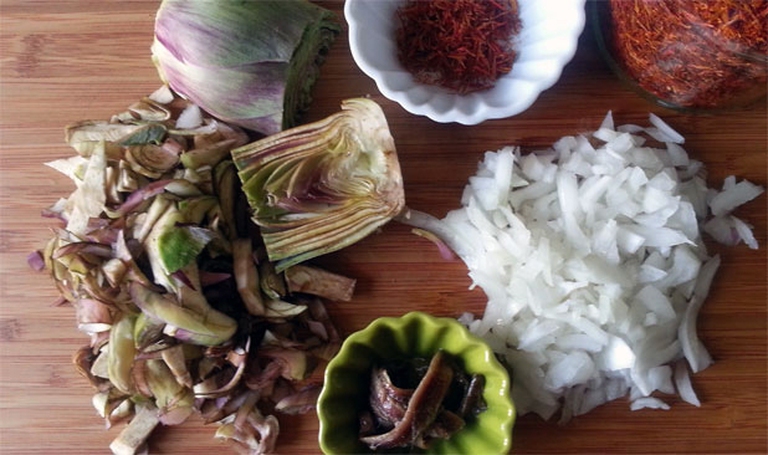
Factory farming conditions and antibiotic-resistant pathogens emerging as a result of them pose an existential threat to humans in the form of zoonotic diseases. Why it’s time to produce and consume food more thoughtfully.
A seasonal, light, tasty and creamy pasta course – even if it doesn’t contain cream – with a spice that enhances the flavour of the other ingredients: saffron.
Ingredients for 4 servings
350 grammes of bucatini pasta
2 artichokes
1/2 white or golden onion
3 small anchovies in oil
100 grammes of soft part of durum wheat bread
1 bag of saffron threads (2 pinches + 1 pinch to garnish)
1 bunch of parsley
extra virgin olive oil
salt
pepper
Preparation
Bring abundant water to a boil in a big pot. In the meantime, strip away the outer and harder leaves of an artichoke, cut the stem and the tips. Cut the artichokes into halves and remove the tassel and the small tips if there are any. Plunge the artichokes in a bowl full of water and lemon juice to stop them from browning. Mince the onion and put the saffron in a bowl, covering it with a spoonful of pasta water. Mix gently. The saffron will colour the water.
Heat the oil and anchovies in a big pan. Stir until they start to melt, then add the onion and sautée for about one minute. Add the coarsely minced artichokes and cook them with the other ingredients. After two minutes add the water and saffron mixture. Cook for another three minutes. Season with salt and pepper. Remove from heat and add the soft part of bread. Stir well until the sauce is pasty.
Boil the pasta and when it is firm remove from heat. Donìt drain the bucatini with a colander, rather, use cooking pliers to put them in the pan where you’ve cooked the artichokes. Add a spoonful of pasta water, mix well. Serve soon and garnish with chopped up parsley and saffron threads.
Siamo anche su WhatsApp. Segui il canale ufficiale LifeGate per restare aggiornata, aggiornato sulle ultime notizie e sulle nostre attività.
![]()
Quest'opera è distribuita con Licenza Creative Commons Attribuzione - Non commerciale - Non opere derivate 4.0 Internazionale.
Factory farming conditions and antibiotic-resistant pathogens emerging as a result of them pose an existential threat to humans in the form of zoonotic diseases. Why it’s time to produce and consume food more thoughtfully.
The world of cinema recognises the link between food choices and the climate crisis by offering vegan menus for awards season events, including at the most important of them all: the Oscars.
Let’s look at the reasons behind the growth of veganism in India, as a small yet vocal section of the population turns towards this diet and lifestyle in the largest milk producing country in the world.
by Jeffrey Y. Campbell, Manager of the Forest and Farm Facility at FAO In the Ecuadorian Amazon, Kichwa farmers grow dozens of products on tiny parcels of land. Their lands hum with biodiversity, yielding nutritious foods that have sustained families for generations. Wandering among fruit and nut trees and crops, these indigenous agroforesters fill their baskets
Mint has many health benefits, but in food it’s often accompanied by artificial green colourings. Instead, Galatea has created a green mint ice cream in a completely natural way.
We’re talking about Galatea, a company that produces semi-finished products for artisanal ice creams using high quality ingredients, natural colouring, excluding thickeners and hydrogenated fats, respecting the environment and supporting the less fortunate.
The mad rush to fake food, like fake meat made with genetically-modified soy, ignores the importance of the diversity of our foods and culinary cultures. It’s a recipe to accelerate the destruction of the Planet and our health.
Like with all foods, the quality of an ice cream can be discerned by reading its label. An expert explains how to do this, and tells us how their company steers clear of chemicals, using only natural ingredients to produce an excellent and “free” ice cream.
Quality ingredients, no artificial colouring and hydrogenated fats. These are the main features of a great ice cream. But what makes an ice cream parlour “good”, i.e. sustainable?








